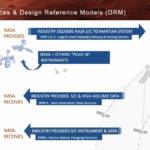WASHINGTON — NASA has selected nine companies to perform feasibility studies of commercial approaches to deliver spacecraft to Mars and provide services there.
The agency announced May 1 the selection of the companies for its “Exploring Mars Together: Commercial Services Studies” program. The nine companies received 12 awards; three of the companies received two each while the other six received a single award.
The contracts, valued at between $200,000 and $300,000 per company, are for 12-week studies to explore four topic areas where commercial services could augment NASA’s broader Mars exploration program: delivery of small spacecraft or hosted payloads to Mars orbit, delivery of large spacecraft or hosted payloads to Mars orbit, Mars imaging services and Mars communication relay services.
For delivery of small spacecraft or hosted payloads, NASA selected Firefly Aerospace, Impulse Space and Lockheed Martin. Firefly and Lockheed each proposed modifying a lunar spacecraft for use at Mars while Impulse Space would adapt a version of a space tug developed for operating in Earth orbit.
For delivery of large spacecraft or hosted payloads, NASA selected Astrobotic, Blue Origin and United Launch Alliance. Astrobotic would modify a lunar lander and Blue Origin would offer a version of its Blue Ring spacecraft, while ULA would adapt an upper stage.
NASA selected Albedo Space, Astrobotic and Redwire for imaging services studies. Albedo will study a version of the spacecraft it is developing to provide high-resolution Earth images, Astrobotic a version of its lunar lander equipped with an imaging payload and Redwire a modified commercial Earth imaging spacecraft.
Blue Origin, Lockheed and SpaceX won awards to study communications relay systems at Mars. Blue Origin would again use a version of Blue Ring, while Lockheed would use a modified Mars orbiter and SpaceX a version of an Earth orbit communications satellite, presumably from its Starlink broadband constellation.
The selected companies provided few additional details about their plans for the studies. Blue Origin, for example, confirmed its studies are based on Blue Ring, the in-space platform it is developing for applications in Earth orbit and beyond, like a potential mission to the near Earth asteroid Apophis.
The studies are linked to a draft Mars exploration plan the agency rolled out more than a year ago to discuss plans for future Mars missions beyond Mars Sample Return. That plan called for flying relatively inexpensive missions, with costs of $100 million to $300 million, during every launch opportunity that is open on a roughly two-year cycle. Those smaller missions would be supplemented by less frequent but larger, more ambitious missions.
That strategy envisioned using commercial capabilities for some roles, like imaging and communications, taking lessons from other NASA commercial initiatives like the Commercial Lunar Payload Services (CLPS) program, where NASA buys payload space on commercial lunar landers.
At an advisory committee meeting in Mars, though, Eric Ianson, director of NASA’s Mars Exploration Program, cautioned that this effort would not be a “Mars CLPS” in that NASA is not asking companies to study landing payloads on Mars. “I think we are a long way away from that,” he said then.
There is strong interest in the scientific community for commercial or other approaches to preserve existing, but aging, capabilities to relay data from the surface and collect high-resolution imagery. That includes the Mars Reconnaissance Orbiter, whose HiRISE camera provides high-resolution imagery. That spacecraft, though, has been in operation for nearly two decades.
“That is definitely something that we’re looking at here,” said Tiffany Morgan, deputy director of NASA’s Mars Exploration Program, about replacing HiRISE with a commercial service during a session of the Mars Exploration Program Analysis Group meeting April 25. “We recognize it as a critical capability that we need.”
NASA said it will release a summary of the studies later this year and use them to support further development of its Mars exploration strategy. The studies are independent from a call for proposals NASA issued April 16 for industry studies to examine new approaches for MSR.
Related
Author Profile
- Space.com is an online publication focused on space exploration, astronomy, skywatching and entertainment, with editorial teams based in the United States and United Kingdom
Latest entries
 ScienceMay 18, 2024It’s time to figure out global space traffic management
ScienceMay 18, 2024It’s time to figure out global space traffic management ScienceMay 12, 2024National Space Council will explore military space and intelligence roles and responsibilities
ScienceMay 12, 2024National Space Council will explore military space and intelligence roles and responsibilities ScienceMay 5, 2024NASA awards studies for commercial Mars missions
ScienceMay 5, 2024NASA awards studies for commercial Mars missions ScienceMay 4, 2024Air Force project blends military and commercial space networks
ScienceMay 4, 2024Air Force project blends military and commercial space networks

